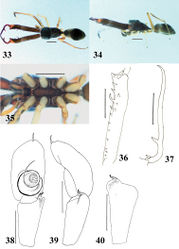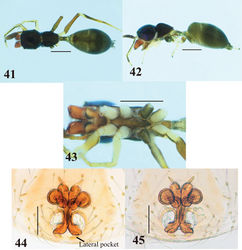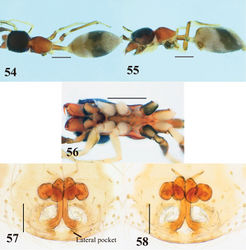Myrmarachne macrognatha
| Notice: | This page is derived from the original publication listed below, whose author(s) should always be credited. Further contributors may edit and improve the content of this page and, consequently, need to be credited as well (see page history). Any assessment of factual correctness requires a careful review of the original article as well as of subsequent contributions.
If you are uncertain whether your planned contribution is correct or not, we suggest that you use the associated discussion page instead of editing the page directly. This page should be cited as follows (rationale):
Citation formats to copy and paste
BibTeX: @article{Yamasaki2013ZooKeys299, RIS/ Endnote: TY - JOUR Wikipedia/ Citizendium: <ref name="Yamasaki2013ZooKeys299">{{Citation See also the citation download page at the journal. |
Ordo: Araneae
Familia: Salticidae
Genus: Myrmarachne
Name
Myrmarachne macrognatha (Thorell, 1894) – Wikispecies link – Pensoft Profile
- Salticus macrognathus Thorell, 1894: 58.
- Myrmarachne macrognatha: Roewer, 1954: 947.
Type material
Holotype male (NRM), Java, [INDONESIA], van Hass. [van Hasselt].
Non-type material examined: 16 males and 11 females, Moni [=8°45'S, 121°51'E], Flores, East Nusa Tenggara Prov., INDONESIA, 17–19.X.2012, T. Yamasaki leg.
Diagnosis
Blackish species; total length approximately 3.2–5.3 mm in males and 4.0–5.2 mm in females. Males distinguished from other species except Myrmarachne smaragdina Ceccarelli, 2010 (cf. fig. 34 in Ceccarelli 2010[1]) by characteristic dentition of chelicera, of which fourth prolateral tooth counted from apex long (Fig. 36); further distinguished from Myrmarachne smaragdina by shapes of chelicera and carapace (figs 28–29 in Ceccarelli 2010[1] vs. Figs 33–34). Females distinguished from other species except Myrmarachne melanocephala MacLeay, 1839 by sclerotized copulatory ducts clearly twisted in “figure 8” (Figs 44–45); Myrmarachne macrognatha distinguished from Myrmarachne melanocephala by absence of distinct markings on abdomen (Figs 41 vs. 54).
Measurements (male/female)
Carapace length 1.63–2.50 (2.23) /1.75–2.10, width 0.93–1.57 (1.38) /0.91–1.08. Chelicera length 1.30–3.85 (3.30). ALE–PLE 0.67–1.02 (0.92) /0.68–0.82; ALE–PME 0.30–0.43 (0.42) /0.26–0.35. Width of eye row I 0.87–1.30 (1.17) /0.93–1.05; II 0.80–1.20 (1.10) /0.85–0.95; III 0.95–1.45 (1.32) /1.02–1.15. Eye size: AME 0.28–0.42 (0.37) /0.31–0.34; ALE 0.15–0.20 (0.18) /0.14–0.16; PME 0.05– (0.08) /0.05–0.06; PLE 0.15–0.23 (0.20) /0.16–0.18.
Male (Figs 33–40). With carapace in lateral view, cephalic part almost flat dorsally, higher than thoracic part; dorsal concavity behind PLE shallow or indistinct; thoracic part sloping downward, not distinctly convex dorsally (Figs 33–34). Chelicera distinctly longer than carapace, each lateral margin almost parallel-sided except for distinctly convex prolateral margin near anterior end of chelicera; venter of chelicera bearing nine to twelve prolateral and three to six retrolateral teeth; fourth prolateral tooth counted from apex long and strongly curved (Fig. 36). Fang almost straight or very weakly sinuous except for curved tip and base, with long tooth-like apophysis on its venter at about 1/4 the length of fang from its base (Fig. 37). Pedicel short (0.18–0.30 mm). Abdomen oval without distinct constriction, with dorsal two scuta that are clearly separated.
With palp in dorsal and ventral views, cymbium elongate-oval, with one apical spine (Fig. 38). Tegulum round and small, with s-curved ejaculation duct in distal retrolateral part of tegulum (Fig. 38). Embolus forming two round coils; embolus coils occupying less than half of venter of cymbium; ventral coil much smaller than basal coil, only about half the diameter (Fig. 38). RTA strongly curved, and in retrolateral view, somewhat spiraled (Fig. 38–40). Flange of RTA moderately developed.
Number of spines on legs. Femur I pd 1, rd 0; tibia I pv 0–3, rv 1–4; metatarsus I pv 2, rv 2; femur II pd 1, rd 0; tibia II pv 0, rv 0–2; metatarsus II pv 0–2, rv 1–2; femur III pd 0–1, rd 0; femur IV pd 1, rd 0.
Coloration in alcohol and pilosity. Carapace black; cephalic part covered with fine white setae, and thoracic part sparsely covered with white setae; lateral carapace not fringed with white setae (Figs 33–34). Chelicera dark brown to black, and long white setae roughly forming transverse band in anterior part of chelicera. Endite and labium brownish orange, tinged with black laterally (Fig. 35). Coxae and trochanters I, III, IV yellow with gray lateral stripes; coxa and trochanter II cream-white, coxa with gray lateral stripes; in large specimens, coxae sometimes strongly tinged with black (Fig. 35). Abdomen and its dorsal scuta black, covered with white long setae and fine setae dorsally (Figs 33–34).
Female (Figs 41–45). With carapace in lateral view, cephalic part weakly convex dorsally, slightly higher than thoracic part; dorsal concavity behind PLE distinct; thoracic part swollen dorsally (Figs 41–42). Chelicera bearing five to six prolateral and six retrolateral teeth on its venter. Pedicel relatively longer than that of males (0.35–0.43 mm). Abdomen oval, without distinct constriction and dorsal scutum.
Epigyne (Figs 44–45). Copulatory atria containing openings oval. Lateral pockets present in front of epigastric furrow, anteroposteriorlly flattened. Sclerotized copulatory ducts clearly twisted in “figure 8” adjacent to cylindal spermathecae, then extending between atria to approximately the area of the lateral pockets.
Number of spines on legs. Tibia I pv 3–4, rv 3–4; metatarsus I pv 2, rv 2; tibia II pv 0, rv 2; metatarsus II pv 0–2, rv 2.
Coloration in alcohol and pilosity. Carapace dark brown to black; cephalic part covered with white and fine setae; thoracic part covered with white setae; lateral surface of carapace above coxae I and II densely fringed with white setae; white setae roughly forming white diagonal band from above coxa IV to upper dorsum (Figs 41–42). Chelicera dark brown. Endite, labium and sternum brownish orange, weakly tinged with black. Coxae and trochanters I and II white; coxa and trochanter III black, trochanter with yellow venter; coxa and trochanter IV pale yellow with lateral gray stripes (Fig. 43). Abdomen gray, covered with fine setae; two spots behind two white partial transverse bands present dorsally in anterior part of abdomen (Figs 41–42).
Remarks
The specimens from Flores are slightly different from the holotype of Myrmarachne macrognatha from Java in the cheliceral teeth. The third prolateral tooth counted from the apex of the Flores specimens is shorter than that of the holotype (which has both the third and fourth teeth elongate). Although the number and size of cheliceral teeth is variable, generally corresponding to body size, the short apical third prolateral tooth seems to be a stable character within our specimens collected from Flores regardless of body size. However, we regard the Flores specimens as Myrmarachne macrognatha on the basis of many other morphological similarities. To understand geographical variation of the species, a phylogenetic study based on molecular analysis is needed in the future.
Biology
Myrmarachne macrognatha is an arboreal species, and very common and abundant in eastern Flores.
Distribution
Java, Flores.
Taxon Treatment
- Yamasaki, T; Edwards, G; 2013: The genus Myrmarachne (Araneae, Salticidae) in Flores, Indonesia ZooKeys, 299: 1-20. doi
Other References
- ↑ 1.0 1.1 Ceccarelli F (2010) New species of ant-mimicking jumping spiders of the genus Myrmarachne MacLeay, 1839 (Araneae: Salticidae) from north Queensland, Australia. Australian Journal of Entomology 49: 245-255. doi: 10.1111/j.1440-6055.2010.00756.x
Images
|


